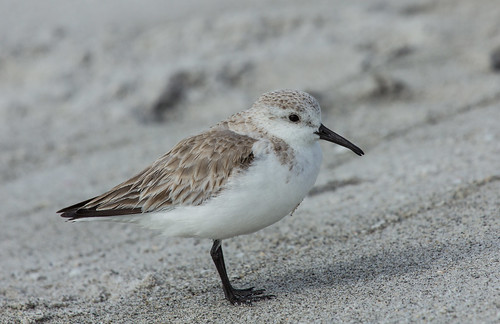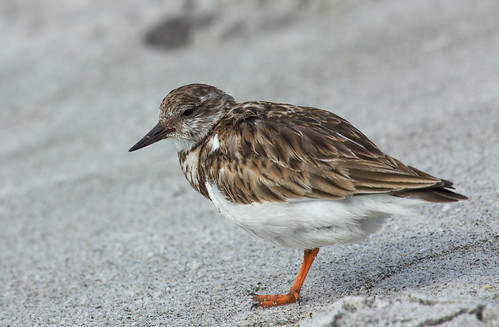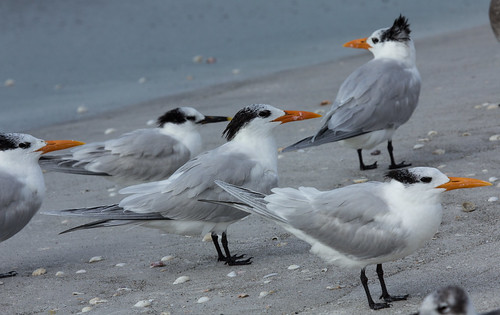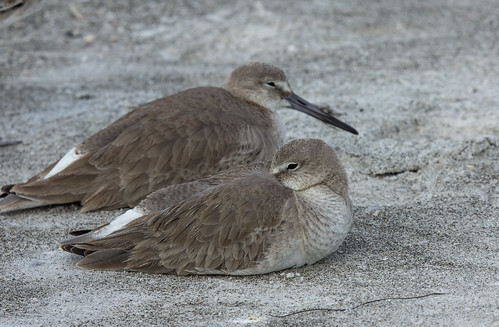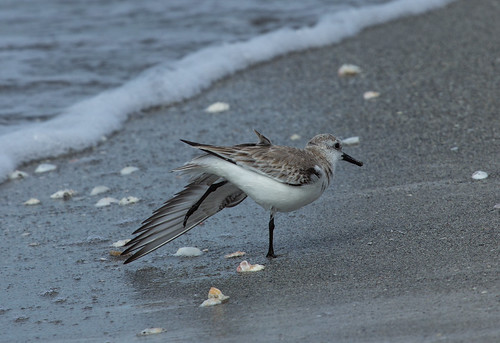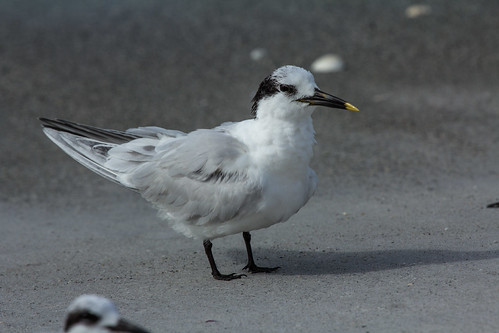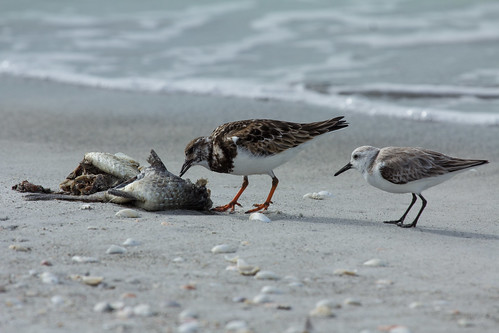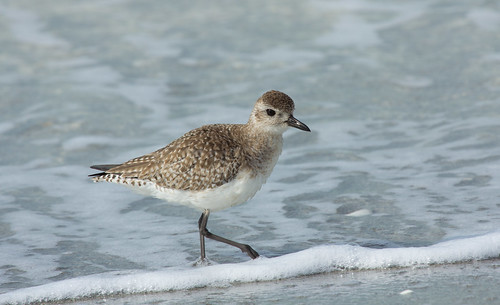Every time I come to Florida I see yet more housing developments and retail malls sprouting up, even as I see foreclosures and shopping strips that have been abandoned. But development continues apace, and birds crowd into what’s left.
The people on Sanibel Island seem to realize how essential for wildlife their shoreline is. Once you cross the bridge onto the island, you can pull over in many places to get onto the shoreline. The only development for a long stretch is occasional restrooms and picnic tables, along with a fairly narrow stretch of drivable sand far enough from the actual beach for shorebirds to cope. Dogs are only allowed on-leash, too, which is wonderful because these white sand beaches are exactly where Piping and Snowy Plovers gather in winter. I was there at high tide, the trickiest time to find many of the shorebirds, and I only got brief, distant looks at two before they flew off, but even a glimpse at these adorable little birds has the power to make me smile all day.
I was headed for Ding Darling–the nickname birders give to J.N. “Ding” Darling National Wildlife Refuge. How did it get its name?
One of America’s most famous political cartoonists during the Great Depression and the years of the Roosevelt administration was Jay Norwood Darling. While he attended Beloit College, he started signing his artwork simply a contraction of his last name, turning “Darling” into “D’ing.” Soon everyone was calling him “Ding.”
Darling’s two passions in life were politics and conservation. He was given the Pulitzer Prize twice, in 1924 and 1943, for editorial cartoons. On the conservation side, he founded the National Wildlife Federation, conceived the Federal Duck Stamp program and drew the first Duck Stamp, and for a time headed the U.S. Biological Survey, which evolved into the US Fish and Wildlife Service.
The National Wildlife Refuge on Sanibel Island named for him protects one of America’s largest remaining undeveloped mangrove ecosystems.
When I got to the refuge, I’d barely cracked my car door open before the meows of Gray Catbirds were greeting my ears. I walked a bit around the parking area by the Visitor Center, looking for songbirds, and then drove the Wildlife Loop, a one-way road going along wonderful habitat. I got splendid looks and photos of two of the refuge’s iconic birds, the Yellow-crowned Night-Heron and Anhinga. Despite the high tide, there were a few large groups of shorebirds, including Black-bellied, Semipalmated, and Wilson’s Plovers, Dunlins, Short-billed Dowitchers, Red Knots, and about 500 Willets—more than I’d ever seen in a single place before. Willets are a rather drab gray when resting or running, but the moment they open their wings—wow. The striking black and white pattern is absolutely beautiful.
One loon rested in a shallow area not far from the first group of shorebirds. It looked rather sick—botulism killed a great many loons in late summer and fall on the Great Lakes this year, and I’m afraid this bird may have been a late casualty of the disease. Four Roseate Spoonbills flew over, two landing pretty far out for photos but near enough to enjoy the bright pink contrasting with all the white egrets they joined. Every species of heron and egret native to Florida gave me decent looks along the wildlife drive. I ended the morning with over 60 species, 40 of them new, boosting the number of species seen on my Conservation Big Year to 122. This does not count the feral domesticated Muscovy Ducks I saw along the drive, though at some point someone will show that they’re established. The new species:
- Northern Shoveler
- Common Loon
- Pied-billed Grebe
- American White Pelican
- Brown Pelican
- Great Blue Heron
- Snowy Egret
- Tricolored Heron
- Reddish Egret
- Green Heron
- Black-crowned Night-Heron
- Yellow-crowned Night-Heron
- White Ibis
- Roseate Spoonbill
- Osprey
- Black-bellied Plover
- Wilson’s Plover
- Semipalmated Plover
- Piping Plover
- Killdeer
- Willet
- Ruddy Turnstone
- Red Knot
- Sanderling
- Western Sandpiper
- Least Sandpiper
- Dunlin
- Short-billed Dowitcher
- Bonaparte’s Gull
- Laughing Gull
- Caspian Tern
- Forster’s Tern
- Royal Tern
- Eurasian Collared-Dove
- Common Ground-Dove
- Belted Kingfisher
- Fish Crow
- House Wren
- Gray Catbird
- Boat-tailed Grackle
After a lovely day, I drove back up to Sarasota, to have dinner with Mr. Borkowski and two of his friends, Chuck and Judy. I stayed overnight at their place on Longboat Key.
